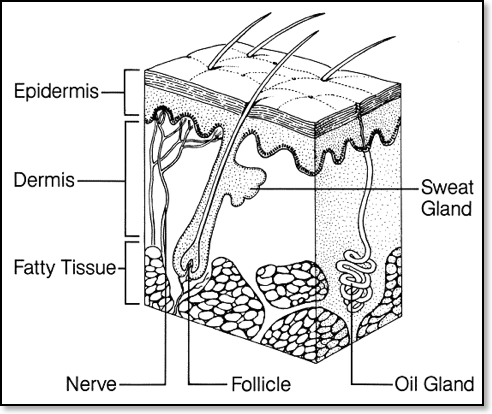Skin Layers
Skin is composed of three layers. Each layer is a complicated structure that contains many different specialized cells.
- Epidermis: The epidermis is the outer layer of the skin and it contains 5 layers. The outer layer of the epidermis is called the stratum corneum and it is responsible for making the skin a barrier against outside forces.
- Dermis: The dermis is the second layer of the skin and it is the scaffolding of the skin. It contains collagen and other types of tissue that give the skin its structure.
- Subcutaneous Tissue: The subcutaneous tissue is the third layer of the skin and it contains fat, lymphatics and the larger blood vessels. This layer is responsible for regulating the temperature of the skin and body as will as bring nutrients to and waste products away from the skin.

Skin Cells
- Basal Cells: These are small round cells found in the deepest layer of the epidermis called the basal layer. Basal cells continually divide, and new cells constantly push older ones up toward the surface of the skin, where they are eventually shed. The basal cell layer is also known as the stratum germinativum due to the fact that it is constantly germinating (producing) new cells. When these become cancerous they are called Basal Cell Carcinoma or BCC for short.
- Melanocytes: . Melanocytes produce pigment known as melanin, which gives skin its tan or brown color and helps protect the deeper layers of the skin from the harmful effects of the sun. Melanocytes are found in the basal layer in between basal cells. Sun exposure causes melanocytes to increase production of melanin in order to protect the skin from damaging ultraviolet rays, producing a suntan. Patches of melanin in the skin cause birthmarks, freckles, and age spots. A benign aggregates of melanocytes in the skin is called a naevus or, commonly, a “mole”. A Melanoma develops when melanocytes become malignant or cancerous.
- Squamous Cells: The squamous cell layer is located above the basal layer and is formed from the basal cells that have been pushed upward. These maturing cells are now called squamous cells, or keratinocytes. Keratinocytes produce keratin, a tough, protective protein that makes up the majority of the structure of the skin, hair, and nails. These cells eventually die and are shed from the skin. When these become cancerous they are called Squamous Cell Carcinoma or SCC for short.
- Merkel Cells: These cells are also located in the basal layer of the epidermis. Whilst it is not completely clear what their role is, it is though that they provide the skin with some form of sensation. A Merkel Cell Carcinoma (MCC) develops when merkel cells become malignant or cancerous.

Skin Functions
Skin performs many jobs besides just covering your body and looking pretty (or handsome). The following are some of the major jobs the skin has to carry out 24 hours a day:
- Barrier: Simply put, skin keeps things from entering your body as well as leaving it. For instance it stops you becoming waterlogged when you swim. Conversely, patients with major burns lose fluid from their body rapidly and are in grave danger when this is not replaced.
- Protection: Skin keeps bacteria, fungi, and viruses from damaging it and entering the body.
- Sensation: Skin helps you sense the world around you.
- Regeneration: Skin repairs wounds.
- Regulate Temperature: Skin helps keep our body temperature within an acceptable range.
- UV Protection: Skin keeps UV rays (sunlight) from damaging your body.





